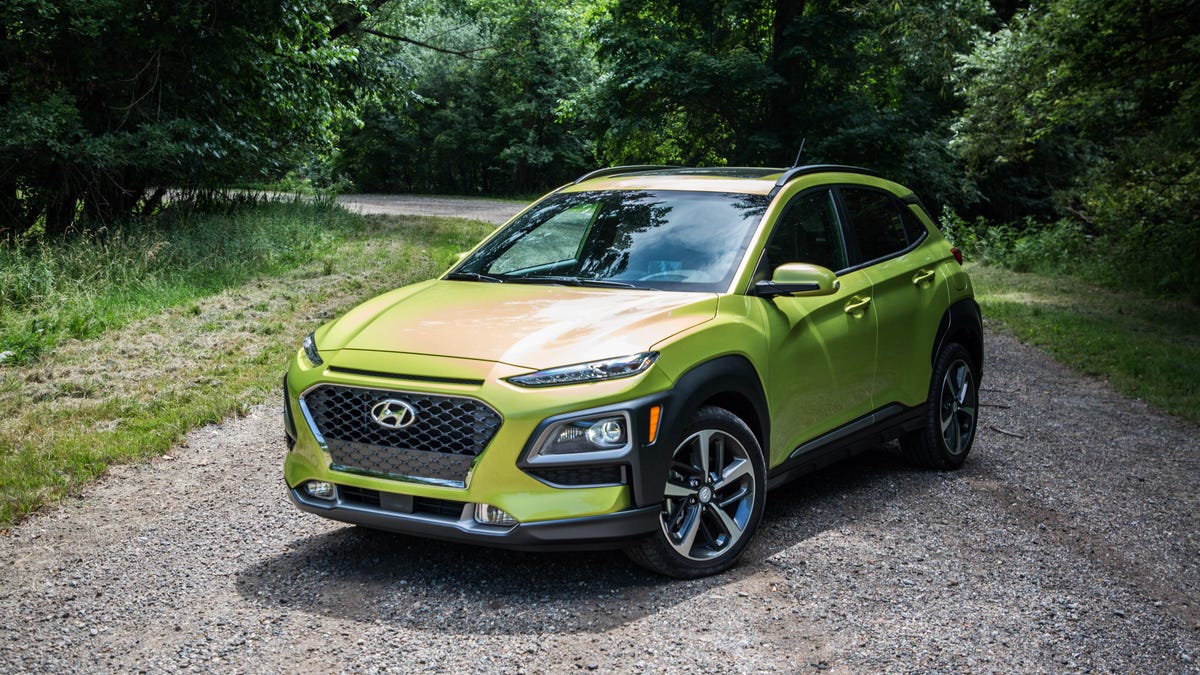2020 Hyundai Kona: Model overview, pricing, tech and specs
Hyundai's subcompact Kona is bursting with personality and packs a lot of features into a small footprint.
Introduced in 2018, the Kona brought a bit of funky flair to the subcompact SUV space. Because it's so new, Hyundai's little guy heads into 2020 with only small updates, wearing the same polarizing exterior as before, packed with class-leading technology and safety features inside.
Click here to read our most recent Hyundai Kona review.
Powertrain and specs
The standard Hyundai Kona is available with two gasoline-powered engines in the US. Hyundai also sells an all-electric Kona EV, but since that's an entirely different model, we won't be including it in this overview.
The Kona's base engine is a 2.0-liter, naturally aspirated I4, making 147 horsepower and 132 pound-feet of torque. A six-speed automatic transmission is standard with this engine, and buyers can choose from front- or all-wheel drive. With front-wheel drive, the 2.0-liter Kona is estimated to return 27 miles per gallon in the city, 33 mpg on the highway and 30 mpg combined, according to the EPA. Choosing all-wheel drive reduces those numbers to 26, 30 and 28, respectively.
Upper-level Konas are powered by a 1.6-liter, turbocharged I4 engine, which makes a healthier 175 horsepower and 195 pound-feet of torque. A seven-speed, dual-clutch automatic transmission is paired with the turbo engine, and we like the smooth, effortless way this powertrain delivers its oomph. Once again, both front- and all-wheel drive are available with the turbo-four. For the former configuration, the turbocharged Kona is estimated to return 28 mpg city, 32 mpg highway and 30 mpg combined. All-wheel drive only takes a small hit on efficiency, dropping the aforementioned numbers to 26 mpg city, 29 mpg highway and 27 mpg combined.
Leather seats and an 8-inch touchscreen are available on top-shelf Ultimate models.
Interior
The Kona is a subcompact SUV, but it offers a decent amount of space for four adults, or five in a pinch. Buyers can choose from cloth or leather upholstery, with bright accent colors o some models. A 7-inch infotainment screen is standard on SE, SEL and Limited trims, while the Ultimate adds a larger 8-inch display -- more on that in a minute.
Despite its subcompact size and low starting price, the Kona can be loaded up with all sorts of features. Of note, the Kona Limited and Ultimate come with leather seating surfaces and heated front seats. (The SEL comes with heated cloth seats.) A head-up display and wireless phone charging are available on higher trim levels.
With the rear seats upright, the Kona can carry 19.2 cubic feet of cargo. Fold the rear seats flat, however, and that luggage area expands to 45.8 cubic feet. That puts the Kona's spaciousness on par with other subcompact SUVs .
Technology
Most Konas use the aforementioned 7-inch central touchscreen, with a 6-speaker audio system, and Bluetooth, Apple CarPlay and Android Auto standard. The 8-inch screen adds embedded navigation with real-time traffic information to the Kona's infotainment roster.
Advanced driver-assistance systems are in high supply. All Kona models come standard with forward collision warning, lane-keeping assist and a driver attention monitor. Rear cross-traffic alert and blind-spot monitoring are standard on all but the base SE, and the top-end Ultimate comes with adaptive cruise control.
The design is certainly polarizing, especially with a bright green paint job.
Pricing
The 2020 Hyundai Kona starts at $20,100, not including $1,095 for destination. Adding all-wheel drive ups the price to $21,500. Standard equipment includes 16-inch wheels and the aforementioned safety systems.
Moving up to the SEL costs $21,900 (FWD) or $23,300 (AWD), and adds niceties like 17-inch wheels, tinted rear windows, a leather-wrapped steering wheel and a contrasting roof option (for $350).
A new SEL Plus trim is available for 2020, priced at $23,750 (FWD) or $25,150 (AWD). This adds fog lights, a power driver's seat, wireless phone charging, a 4.2-inch display in the gauge cluster, BlueLink connected car services and an upgraded Infinity audio system.
The Kona Limited comes in at $25,900 (FWD) or $27,300 (AWD) and gets you a multilink rear suspension (with all-wheel drive), the turbocharged engine, 18-inch wheels, LED headlights, LED taillights, leather seats and more. The upper-crust Ultimate adds adaptive cruise control, the 8-inch touchscreen, rain-sensing wipers and more to the Limited's list of equipment, and ups the price to $27,750 (FWD) or $29,150 (AWD).
Availability
The 2020 Hyundai Kona is on sale now.


